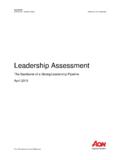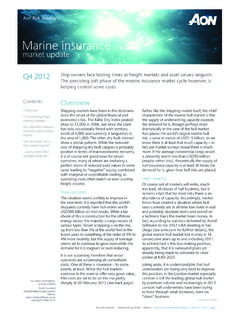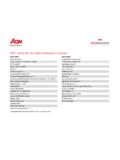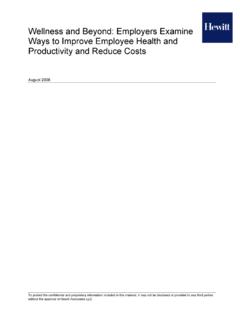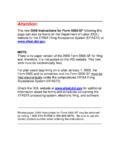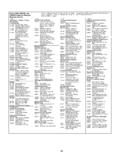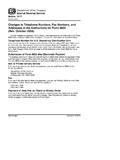Transcription of A Compliance Blueprint for 403(b) Plan Sponsors
1 A Compliance Blueprint for 403(b) Plan Sponsors October 2010 Date Aon Hewitt 2010 Aon Corporation Brief Description: Final 403(b) regulations have given plans Sponsors significant Compliance and administration challenges. In this article we provide 403(b) plan Sponsors with a roadmap to comply with these regulations. Consulting | Retirement 1 I. Introduction II. Where We ve Been III. The New 403(b) Environment IV. Roadmap for Compliance and Beyond Final 403(b) regulations have significantly changed the administration and Compliance requirements for Sponsors of 403(b) plans. The rules are particularly challenging for Sponsors of 403(b) plans which offer multiple investment service providers. The final rules were generally effective January 1, 2009 and apply to both ERISA 403(b) plans (with employer contributions) and non-ERISA 403(b) plans (employee contributions only).
2 Plan Sponsors already should have taken action to comply with these regulations. If you are one who has not, however, the time to act is now. The objective of this paper is to: Describe the historical context in which 403(b) plans have traditionally been administered; Summarize the Compliance requirements that 403(b) plan Sponsors must be aware of; Outline steps to bring a 403(b) plan into Compliance ; and Discuss best practices for 403(b) plan Sponsors . Where We ve To understand how complex the new regulations are, it helps to have some background on how 403(b) plans have been handled in the past. Historically, most 403(b) plan Sponsors paid very little attention to their plans. Plan documents were loosely prepared and often not written down. In some situations, the plan was essentially made up of individual contracts negotiated directly between employees and the investment service provider.
3 Participants were left to fend for themselves. There was very little, if any, oversight of plan administration, eligibility, or participation, and there were typically limited efforts to communicate the plan to employees. In fact, administrative requirements were often unclear and misunderstood, and therefore ignored. There was also virtually no oversight of plan investments. Plan Sponsors took the position that by offering multiple investment service providers they were mitigating their risk because employees had virtually unlimited choices. In essence, investments were uncontrolled, unlimited, and often duplicative. In short, prior to the promised enforcement of the regulations, 403(b) plan Sponsors took a hands-off approach with the belief that this would minimize their responsibility and thus limit their risk. The New 403(b) Environment The final 403(b) regulations changed nearly every aspect of plan administration and oversight.
4 Gone are the days where less is better when it comes to monitoring things such as plan administration in general, Compliance with plan provisions, and investment performance. Plan documents must be written and in full Compliance with IRS and DOL requirements. The administration of the plan must be coordinated across all vendors including monitoring employee participation requirements, limits on contributions and pay, and investment selection and performance. The requirements are quite daunting and include the following: Consulting | Retirement 2 Written Plan Document The plan must be memorialized in a single written plan document that meets all of the requirements of the final regulations in both form and operation. Plan Sponsors need to inventory all current vendor contracts, resolve any inconsistencies, and develop a single plan document incorporating and clearly defining all the key provisions of the plan ( eligibility, vesting, contributions, loan provisions, etc.)
5 , so that a participant can understand. For many plans, this means that not only formal language that has been in place needs to be documented, but also informal agreements that may not have been written anywhere. The IRS has developed a prototype document for 403(b) plans, but this prototype covers only the most basic of situations, so many Sponsors will be left on their own to develop compliant documents. Coordinating Administration Across Multiple Vendors What many Sponsors considered prudent in the past is now backfiring on them. In the days of no real rules and no regulatory oversight, large numbers of Sponsors took the position that by allowing as many vendors as were interested in serving the plan participants that they were not exercising their discretion and weren t even responsible for plan oversight. The final regulations essentially force the plan sponsor to have a means for coordinating plan administration across all vendors.
6 For 403(b) plan Sponsors , oversight is now a requirement and the fewer providers that they need to monitor the better. But, how will they decide which vendors to eliminate? How will they communicate these changes to plan participants? Do the existing contracts have back-end fees that will be assessed against participant s account balances if they are forced to move from one provider to another? These and other similar questions are part of the new 403(b) world. Among other things, plan Sponsors are now being encouraged to have Information Sharing Agreements (ISA) in place with each provider to facilitate the coordination of plan provisions and legislative limitations. Examples include: Limits on contributions must be tracked across all providers. Plan-to-plan transfers may only be made to approved service providers with whom the plan sponsor has an ISA in place. Severance and termination information must be communicated across all vendors for processing distributions and calculating vesting.
7 Perhaps the most complicated aspect of the regulations is loan administration. Loan limits apply on an individual participant basis, so in determining the amount available for a loan ( generally lesser of 50% of the vested balance or $50,000) all balances and all loans with every provider must be taken into consideration. Also, loans repayments must be parsed out to each provider with whom the participant has an outstanding loan. Sponsors must have a solution in place for the physical parsing of repayments and transmission to each provider. Even plans not subject to ERISA have aggregation requirements for administration and coordination of contribution limits, loans, withdrawals, plus certain additional provisions. This requires every plan sponsor to monitor, at some level, the administrative work done by each of its vendors. This requirement becomes significantly more important for plans that are subject to ERISA and have a fiduciary obligation to ensure that services are delivered in accordance with contract terms and that the associated fees are reasonable.
8 Fiduciaries are required to ensure the plan is being administered and maintained in the best interest of participants and according to the contracts, agreements, and any other legally binding documents. Consulting | Retirement 3 Controlled Group Considerations - Another important consideration is the determination of whether an organization is part of a controlled group of organizations. Generally, where there is at least 80% common ownership among two or more organizations ( sister organizations, wholly-owned subsidiaries, etc.), the organizations must be treated as a single employer for purposes of coverage testing and nondiscrimination testing. In the tax-exempt arena, this distinction is often vague. Consolidating employee data from multiple business units for testing can be very tedious and complicated. This typically requires pulling participant and plan data from multiple sources and multiple vendors, and identifying one vendor to aggregate the information and perform the required testing.
9 It is common for large not-for-profit hospitals to have a for-profit entity under common ownership. The for-profit entity must also be taken into consideration for controlled-group determination. The existence of a for-profit entity requires special consideration for testing purposes. Failure to accurately assess the ownership and controlled group issues could have significant Compliance implications. Failure to comply could have significant financial consequences for both plan participants and the organization. Monitoring Investments The historical hands-off approach of permitting numerous investment vendors to participate in the 403(b) plan has now created significant issues for many plan Sponsors . Most Sponsors will now have a hands-on fiduciary obligation to monitor each investment and each investment provider to determine their appropriateness for inclusion in the plan.
10 Further, they should establish procedures for ongoing selection and monitoring of investment offerings. Monitoring Vendor Performance As was the case in the past with respect to investment fund monitoring, 403(b) plan Sponsors did not feel any type of urgency to monitor vendors or their services. Many Sponsors treated the vendor arrangements as an agreement between the employee and the vendor, and the employee would control their movement from one vendor to another if they deemed it appropriate. The final regulations place significantly more responsibility and accountability for monitoring vendor performance on the plan sponsor. form 5500 and Audit Requirements Audit and form 5500 requirements have changed. Plans that previously had to file only a limited scope form 5500 are now required to prepare a form 5500 filing that is consistent in scope with what has historically been the standard for 401(k) plans.

